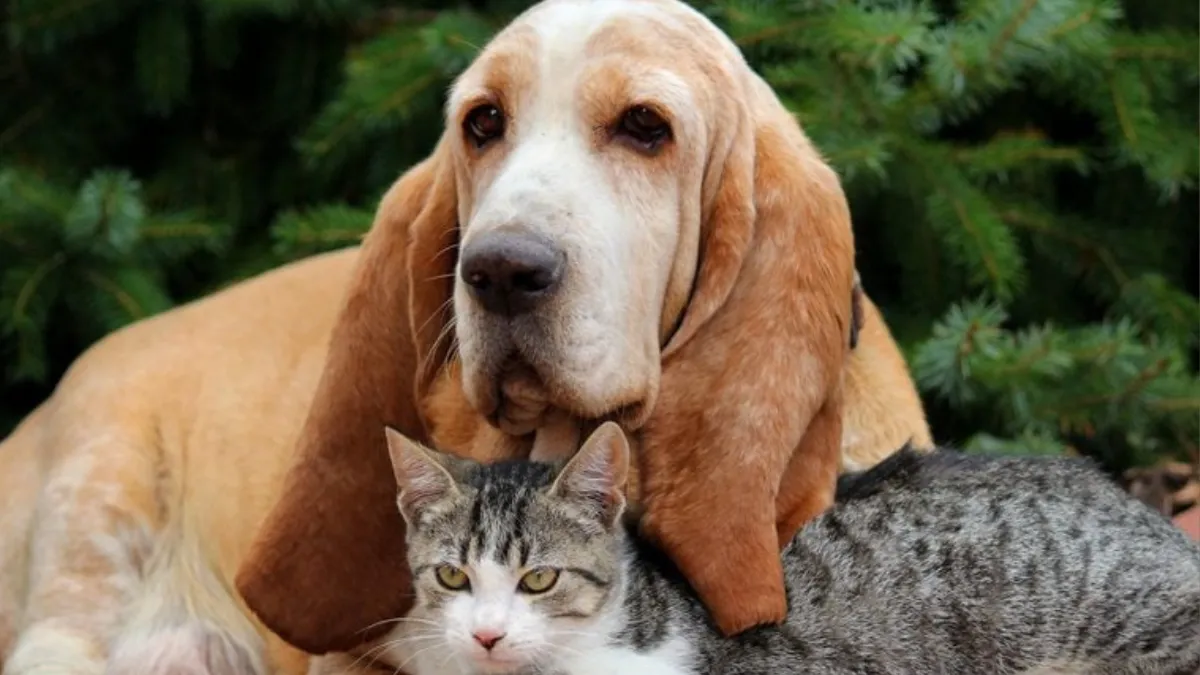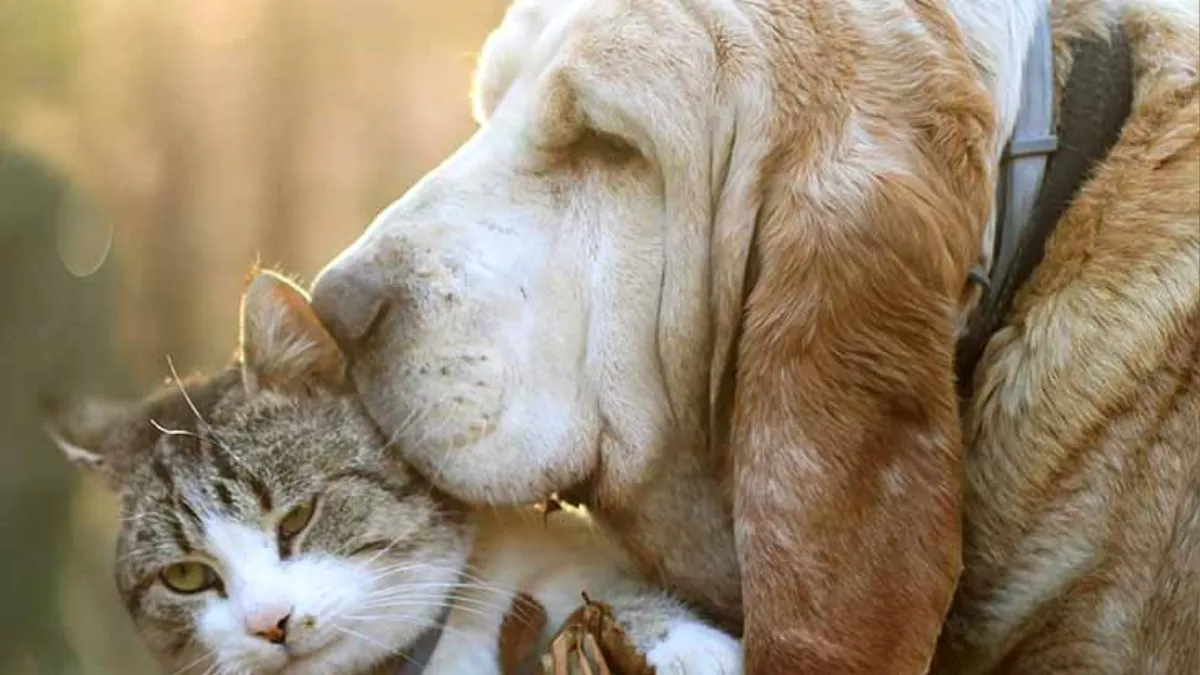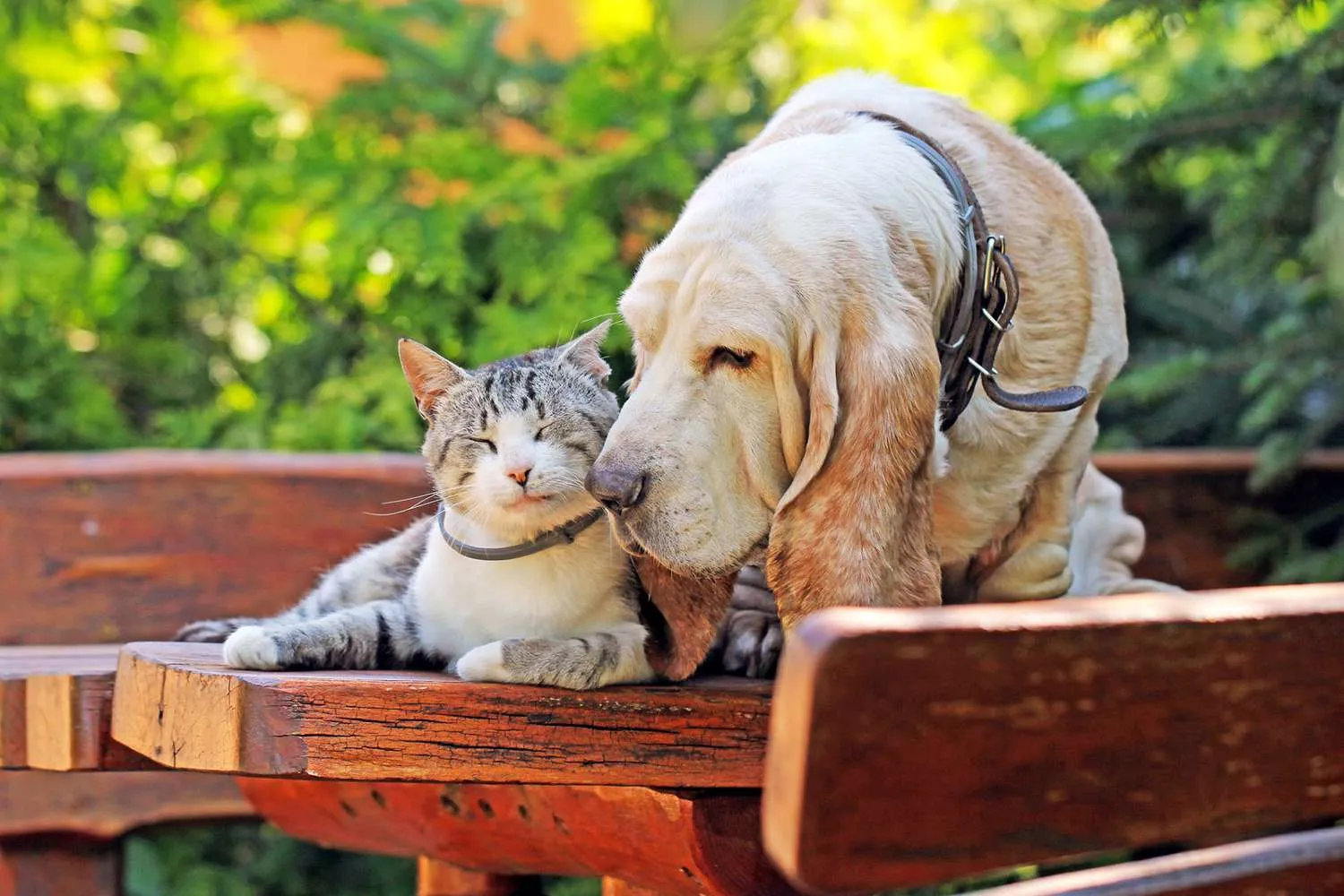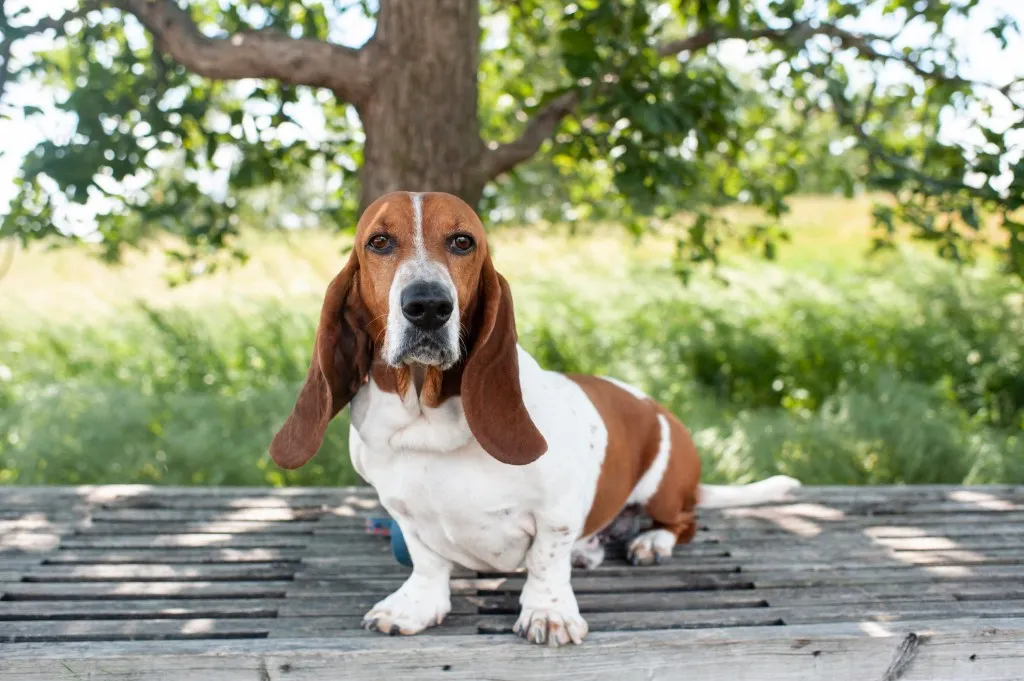Basset hounds are known for their long ears, droopy eyes, and friendly demeanor. They are a popular breed among families due to their affectionate personality and easy-going nature. However, if you are a cat owner, you may be wondering if a basset hound would be a good addition to your household. The question remains: Are basset hounds good with cats?
While basset hounds are generally friendly and sociable, it is important to note that each dog has its personality and temperament. Some basset hounds may be more tolerant of cats, while others may not get along with them at all. It is important to introduce the two animals slowly and under close supervision to ensure a positive interaction. In this article, we will explore whether basset hounds are good with cats and provide tips on how to introduce them to each other.
Basset Hound Temperament
Basset Hounds are known for their calm and easygoing nature, making them an excellent choice for families with children and other pets. Their sociable personality also makes them great companions for other animals.

Calm and Easygoing Nature
Basset Hounds have a peaceful temperament and are not easily agitated. They are known for their laid-back attitude and are content to spend most of their time lounging around. They are also very patient and gentle, which makes them great with children.
Basset Hounds are not overly excitable, which makes them a good choice for families who want a calm and relaxed dog. They are also not known for being aggressive, which makes them a safe choice for families with young children.
Sociable With Other Animals
Basset Hounds are sociable dogs and get along well with other animals, including cats. They are not known for being territorial and are happy to share their space with other pets. They are also not known for being predatory, which makes them a safe choice for families with cats.
Basset Hounds have a friendly personality and are not typically aggressive towards other animals. They are also not known for being overly dominant, which makes them a good choice for families with other pets.
In summary, Basset Hounds have a calm and easygoing temperament and are sociable with other animals, making them a great choice for families with cats or other pets.

Introducing Basset Hounds to Cats
When introducing a basset hound to a cat, it is important to take things slow and be patient. Here are some tips for introducing basset hounds to cats.
Initial Introductions
When introducing a basset hound to a cat for the first time, it is best to keep the interactions short and sweet. Start by allowing the cat to sniff the basset hound from a distance, while the basset hound is on a leash. This will allow both animals to become familiar with each other's scent.
Once the cat and basset hound are comfortable with each other's scent, you can allow them to interact in a controlled environment. It is important to supervise these interactions at all times and to keep the basset hound on a leash until you are confident that they will not harm the cat.
Supervised Interactions
When supervising interactions between a basset hound and a cat, it is important to give both animals equal attention. This will help to prevent jealousy and aggression.
It is also important to teach your basset hound basic commands, such as "sit" and "stay". This will help you to control your basset hound's behavior around the cat.
Overall, basset hounds can be good with cats if introduced properly and with the right supervision. With patience and attention, your basset hound and cat can become the best of friends.

Basset Hounds' Behavior Around Cats
Basset Hounds are known for their gentle and easy-going nature, making them a great addition to any household. However, if you have a cat at home, you may be wondering if your new furry friend will get along with your feline companion. Here are some things to keep in mind when introducing a Basset Hound to a cat.
Reading Body Language
It is important to pay attention to the body language of both your Basset Hound and your cat. If your Basset Hound is wagging their tail and approaching the cat with a relaxed posture, it is a good sign that they are friendly and curious. However, if your Basset Hound is growling, barking, or showing signs of aggression, it may be best to separate them from the cat.
Similarly, if your cat is hissing or arching their back, it is a sign that they feel threatened or uncomfortable. In this case, it is important to give your cat space and time to adjust to the new addition to the household.
Managing Territorial Behaviors
Basset Hounds can be territorial, especially when it comes to their food and toys. It is important to establish clear boundaries and rules for both your Basset Hound and your cat. For example, you may want to feed them in separate areas to avoid any food-related aggression.
It is also important to reward positive behaviors and discourage negative behaviors. If your Basset Hound and cat are getting along well, be sure to praise them and give them treats. However, if your Basset Hound is showing signs of aggression towards your cat, it is important to discourage this behavior and redirect their attention to something else.
In conclusion, Basset Hounds can be great with cats if introduced properly and given time to adjust. By paying attention to their body language and managing any territorial behaviors, you can ensure a happy and harmonious household for both your furry friends.

Training for Harmony
Basset hounds are generally good with cats, but it is important to train them properly to ensure a harmonious relationship between the two pets. Training basset hounds involves teaching them obedience and positive reinforcement techniques.
Obedience Training
Obedience training is an essential part of training basset hounds. It involves teaching the dog basic commands such as "sit," "stay," and "come." These commands are important for controlling the dog and preventing it from chasing or harassing the cat.
A dog trainer can help with obedience training. They can teach the basset hound the basic commands and guide how to reinforce the training at home. It is important to be consistent with the training and to practice regularly to ensure that the dog retains the commands.
Positive Reinforcement
Positive reinforcement is a training technique that involves rewarding the dog for good behavior. This technique can be used to encourage the basset hound to behave well around the cat. For example, if the dog approaches the cat calmly and does not show any signs of aggression, it can be rewarded with a treat or praise.
It is important to use positive reinforcement consistently and to avoid punishing the dog for bad behavior. Punishment can lead to fear and anxiety, which can make the dog more likely to act aggressively towards the cat.
In conclusion, addressing the question "Are Basset Hounds Good with Cats?" entails obedience training and positive reinforcement. Seeking guidance from a dog trainer on effective techniques for fostering good behavior is essential. With consistent training, Basset Hounds can establish a harmonious relationship with cats, promoting peaceful coexistence. Emphasizing the importance of training and positive reinforcement underscores the key elements for successfully integrating Basset Hounds and Cats into a balanced and enjoyable companionship.
Exercise and Energy Levels
Basset Hounds are a breed that is known for being laid-back and low-energy, but they still require daily exercise to maintain their physical and mental health. In this section, we'll discuss the exercise needs of Basset Hounds and how to manage their low energy levels.
Daily Exercise Routines
Basset Hounds should have a daily exercise routine that includes both physical and mental stimulation. A 30-minute walk or jog in the morning and evening can provide the necessary physical exercise. Additionally, playing games like fetch or hide-and-seek can provide mental stimulation.
It is important to note that Basset Hounds tend to become overweight, so it is important to monitor their food intake and adjust their exercise routine accordingly.
Managing Low-Energy Bassets
While Basset Hounds are generally low-energy, some individuals may be even more laid-back than others. It is important to manage their low energy levels to prevent obesity and other health issues.
One way to manage a low-energy Basset Hound is to provide toys and games that are mentally stimulating, such as puzzle toys or scent games. These types of activities can provide mental stimulation without requiring a lot of physical activity.
Another way to manage a low-energy Basset Hound is to provide short bursts of exercise throughout the day. For example, taking a quick walk around the block or playing a game of tug-of-war can provide the necessary physical activity without overwhelming the dog.
Overall, Basset Hounds are a breed that requires daily exercise and mental stimulation to maintain their health and happiness. With the right exercise routine and management techniques, Basset Hounds can be playful and energetic companions that are great with cats.

Creating a Cat-Friendly Environment
When introducing a basset hound into a home with cats, it is important to create a cat-friendly environment to ensure the safety and comfort of all pets involved. This section will cover two important aspects of creating a cat-friendly environment: providing safe spaces for cats and basset hound-proofing your home.
Safe Spaces for Cats
Cats need a safe space where they can retreat when they feel threatened or overwhelmed. This can be a room, a crate, or a piece of furniture that is designated as their own. It is important to provide cats with a space that is inaccessible to the basset hound, where they can eat, sleep, and play without fear of being bothered.
Basset Hound-Proofing Your Home
Basset hounds are known for their strong sense of smell and their territorial nature. To prevent any territorial disputes between cats and basset hounds, it is important to keep their scents separate. This can be achieved by feeding them in different areas of the house and providing separate toys and bedding.
In addition, it is important to basset hound-proof your home by securing any potential hazards, such as electrical cords or toxic plants. Basset hounds are also known for their love of chewing, so it is important to provide them with appropriate chew toys to prevent them from destroying furniture or other items in the home.
By creating a cat-friendly environment and basset hound-proofing your home, you can ensure a peaceful coexistence between your basset hound and cats.
Health and Care Considerations
Nutritional Needs
Basset Hounds are known to tend to become overweight, so it is important to monitor their diet and ensure they receive the appropriate amount of exercise. A high-quality dog food that is formulated for their size and activity level is recommended. It is also important to avoid overfeeding and to provide healthy treats in moderation.

Grooming and Drooling
Basset Hounds have a short, smooth coat that requires minimal grooming. However, they are known for their excessive drooling, which can be managed with regular wiping of the mouth and chin. Additionally, their long ears should be checked regularly for signs of infection or irritation.
Overall, Basset Hounds make great pets for families with cats. However, like all breeds, they require attention, exercise, and proper care to maintain their health and happiness.
Choosing the Right Basset Hound
When it comes to choosing the right Basset Hound, there are a few things to keep in mind. Basset Hounds are known for their friendly and affectionate nature, making them great family pets. However, it is important to consider their compatibility with other pets in the household, especially cats.
Selecting a Basset Hound
When selecting a Basset Hound, it is important to find a reputable breeder who prioritizes the health and well-being of their dogs. A good breeder will provide information on the temperament of their puppies and the temperament of the parents. This can help determine whether a Basset Hound is a good fit for a household with cats.
Understanding Basset Hound Puppies
Basset Hound puppies are known for their playful and curious nature. However, it is important to keep in mind that they can be stubborn and difficult to train. It is important to establish boundaries and rules early on to prevent any unwanted behaviors towards cats or other pets in the household.
When introducing a Basset Hound puppy to a cat, it is important to supervise the interaction and provide positive reinforcement for good behavior. This can help establish a positive relationship between the two animals.
Overall, Basset Hounds can be good with cats if properly socialized and trained. However, it is important to consider the individual personality and temperament of each dog and cat before introducing them to each other.

Conclusion:
In conclusion, when asking, "Are Basset Hounds Good with Cats?" individual temperament and early socialization play crucial roles. Basset Hounds, generally amiable, can become great companions for feline friends. The key lies in gradual introductions, supervised interactions, and positive reinforcement to address their natural curiosity due to a strong scent drive.
Early exposure sets the stage for a harmonious relationship. While pet personalities vary, patient integration and a calm environment enhance the likelihood of success. Responsible pet ownership entails understanding the unique dynamics, monitoring interactions, and providing a secure space for both Basset Hounds and cats to coexist harmoniously.
Frequently Asked Questions
- How do Basset Hounds typically behave around cats?
- Basset Hounds are known to be friendly and gentle dogs, but their behavior around cats may vary. Some Basset Hounds may be curious and playful, while others may ignore cats altogether. It is important to note that every dog is different and their behavior may be influenced by their personality, past experiences, and training.
- What characteristics make some dog breeds more compatible with cats?
- Dog breeds that have a low prey drive and are generally calm and friendly tend to be more compatible with cats. Dogs that have been socialized with cats from a young age are also more likely to coexist peacefully with feline pets.
- Which medium-sized dog breeds are known to coexist peacefully with feline pets?
- Some medium-sized dog breeds that are known to coexist peacefully with cats include Bichon Frise, Cavalier King Charles Spaniel, Cocker Spaniel, Golden Retriever, Labrador Retriever, and Poodle. However, it is important to remember that every dog is an individual and their behavior may vary.
- Can you recommend dog breeds for households with cats that are suitable for first-time owners?
- Some dog breeds that are suitable for first-time owners and are known to coexist peacefully with cats include Beagle, Bichon Frise, Cavalier King Charles Spaniel, Cocker Spaniel, Golden Retriever, Labrador Retriever, and Poodle. However, it is important to research and choose a breed that fits your lifestyle and personality.
- What are the considerations when adopting a dog into a home with a resident cat?
- When adopting a dog into a home with a resident cat, it is important to consider the temperament and behavior of both animals. Introducing a new dog to a resident cat should be done slowly and carefully, and under supervision. It is also important to provide each animal with their own space and resources to prevent conflicts.
- How do I introduce a Basset Hound to a cat to ensure a harmonious relationship?
- To introduce a Basset Hound to a cat, it is important to do it gradually and under supervision. Start by keeping them in separate rooms and allowing them to sniff each other's scent. Then, gradually introduce them while keeping them on a leash and rewarding positive behavior. It is also important to provide each animal with their own space and resources to prevent conflicts.




